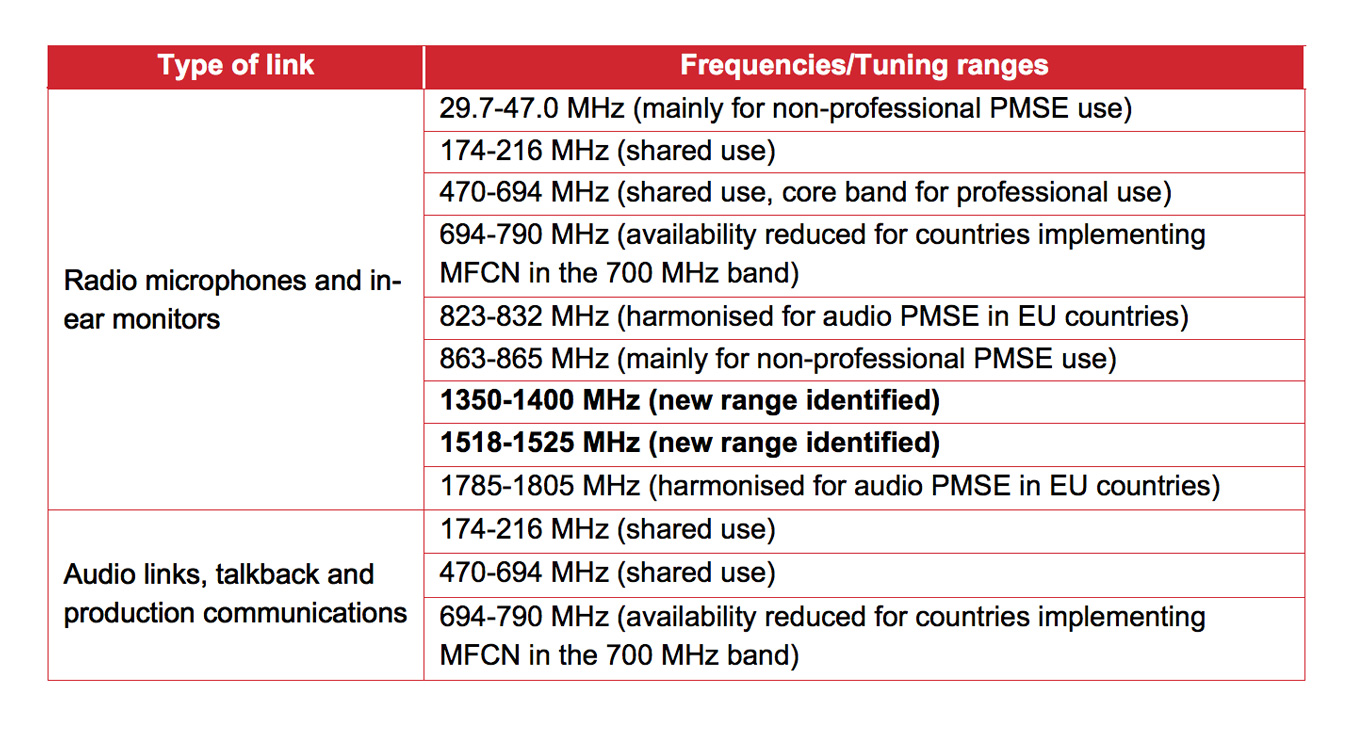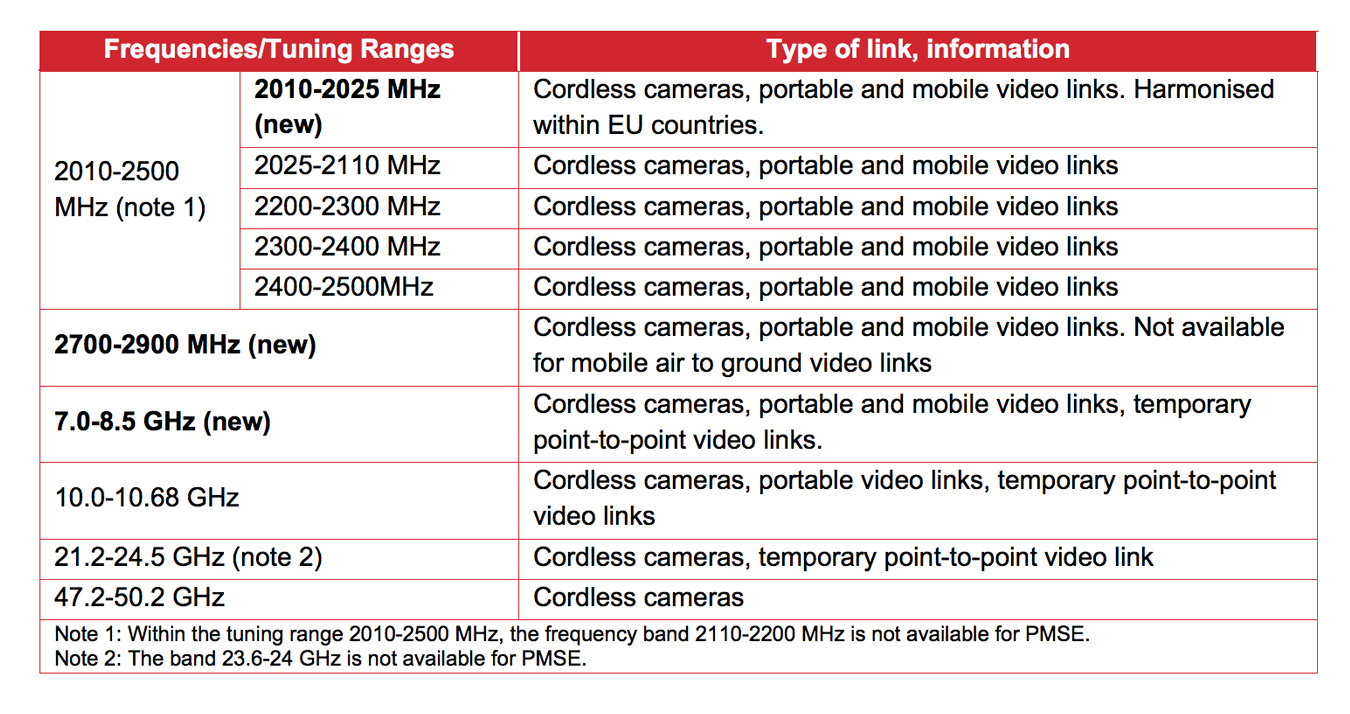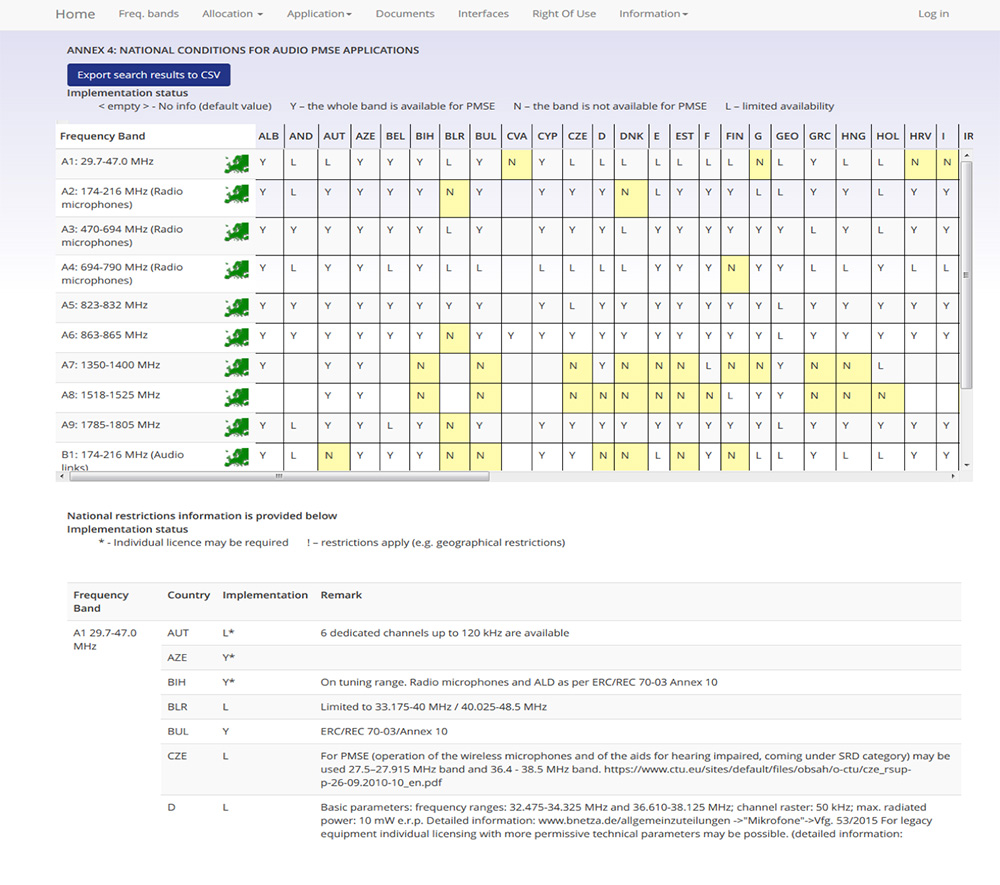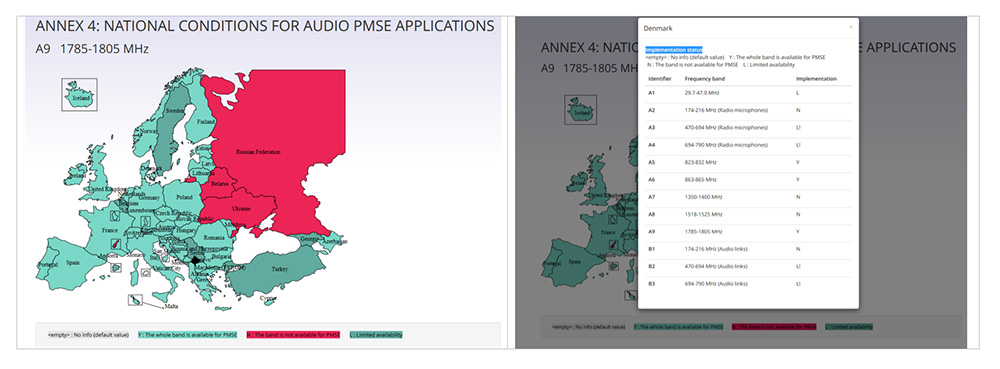Opportunities for spectrum for PMSE applications
If you plan to attend a sporting or cultural event this Autumn, spare a moment to imagine what is going on behind the scenes. Key to the success of that event are programme making and special event (PMSE) applications. They support broadcasting, information, sports and culture events, and include everything from radio microphones and audio applications (such as talkbacks and ear monitors), cordless cameras and relevant video links.
In recent years, available spectrum for PMSE applications has been reduced. This is due to the fact that some parts of the spectrum, previously used by these applications, have been targeted for other uses, in particular with the designation of new frequency bands for mobile broadband. Thus, in accordance with its 2015-2020 strategic plan, the ECC has been working on identifying suitable spectrum for PMSE to compensate for this reduction.
Spectrum demand for PMSE is generally time and location specific. On this basis, and taking also into account the divergent national frequency plans across CEPT countries, spectrum for PMSE is identified on a ‘tuning range’ basis. The term ’tuning range’ for PMSE means a range of frequencies over which radio equipment is envisaged to be capable of operating. Within this tuning range, the use in any one country of radio equipment will be limited to the range of frequencies identified nationally (if any) within that country for PMSE. It will be operated in accordance with the related national regulatory conditions and requirements.
Progress in technology has meant that equipment can now tune over a wider piece of spectrum. This allows the identification of large tuning ranges, and provides administrations with the flexibility to identify, within any given range, the spectrum available for PMSE, depending on demand and national conditions.
In order to facilitate the development of standardised PMSE equipment, ERC Recommendation 25-10 was set up in 1995. Its main target is to identify harmonised tuning ranges for these types of applications. Since then, it has been amended a couple of times to reflect the changes in the spectrum use and to include new opportunities for spectrum for PMSE. The latest version, developed within Project Team FM 51 and published in October 2016, represents a significant step towards harmonisation, whilst maintaining some flexibility for CEPT administrations to account for national circumstances. It is reflected through the consolidation of the frequency ranges available for PMSE across CEPT and the rationalisation, as far as possible, of the terminology and usage conditions.
Identifying new spectrum opportunities for radio microphones
An overview of the frequency ranges currently available in CEPT for audio PMSE applications is provided in Table 1.
Table 1: Frequency ranges included in ERC Recommendation 25-10 for use by audio PMSE applications

The recent review of ERC Recommendation 25-10 provided the opportunity to include two new frequency ranges for audio PMSE with associated technical conditions. This was the result of studies assessing the compatibility between audio PMSE systems and the incumbent use of these ranges:
- 1350 - 1400 MHz: Identified for radio microphones with a maximum equivalent isotropically radiated power (e.i.r.p.) of 20 mW, noting that a maximum e.i.r.p. of 50 mW may be allowed in the case of body-worn radio microphones or for equipment with Spectrum Scanning Procedure (SSP) implemented.
- 1518 – 1525 MHz: Identified for radio microphones for indoor use with a maximum e.i.r.p. of 50 mW.
These new spectrum opportunities, together with technological developments which potentially lead to a more efficient use of the spectrum, should help to respond to a lot of the demand for audio PMSE.
The availability of the band 694-790 MHz for PMSE has been reduced due to its identification for mobile/ fixed communication networks (MFCN). In order to compensate for this reduced availability, the ECC is looking at further possibilities. This would help in addressing peak demands, such as large events or locations with a potential high density of transmitters (for example, production studios, theatres, etc). As a result, and following a national initiative from the United Kingdom, ECC recently started investigating the possible use in Europe of low-power audio PMSE in the band 960-1164 MHz. This task won’t be easy: the band is already used extensively by a range of aeronautical systems for civil aviation and military purposes.
Looking at additional frequencies for cordless cameras and video links
As illustrated in table 2 below, spectrum below 3 GHz is the prime range for the use of cordless cameras and other wireless video applications. This is due to the advantageous radio wave propagation conditions, relatively low signal attenuation and the amount of equipment available. The use of higher frequencies (e.g. above 10 GHz) is currently limited.
Table 2: Frequency ranges included in ERC Recommendation 25-10 for use by video PMSE applications

Due to the reduction in the availability of some frequency bands previously used for video PMSE (such as the 2500-2690 MHz band for example), ECC has been looking at new frequency bands for these applications. It has identified two opportunities below 3 GHz:
- 2010 - 2025 MHz: This band, previously assigned to mobile operators (as part of the ‘2GHz unpaired bands’), has remained unused by mobile networks. It has the advantage of being adjacent to the 2025 - 2110 MHz range, which is already used for video PMSE. The identification of this band under similar conditions will extend the available tuning range and will benefit from existing technology.
- 2700 - 2900 MHz: This band is used mainly for air traffic control and meteorological radars. There have been extensive studies on the potential impact from video PMSE systems into existing systems in this and adjacent bands. As a result of the studies, ECC identified some opportunities for video PMSE use in 2700 - 2900 MHz. The conditions for the use of the band, subject to a proper coordination, are summarised in CEPT Report 61, which was developed in response to a Mandate from the European Commission on the subject. Additional activities are ongoing within Project Team FM 51 on the development of guidelines for the deployment of cordless cameras and relevant video links in the band.
In addition, the identification of tuning ranges in higher frequencies has been studied. As a result, the tuning range 7 - 8.5 GHz has been added to the possible frequency ranges for cordless cameras and relevant video links. It reflects the fact that some portions of this range had already been assigned on a national basis for video PMSE applications, and that sharing opportunities exist with the main uses of this range (e.g. fixed links, satellite services).
Extending the amount of information on the national conditions for PMSE use
The operation of PMSE equipment in many CEPT member states requires appropriate authorisation of the frequencies to be used by that PMSE equipment. Availability of specific frequency ranges for PMSE, conditions of use of these ranges and the national authorisation scheme, may differ greatly between the various CEPT member administrations. In addition, it is important to note that a number of PMSE uses, in particular those of news gathering, happen at unpredictable times and locations, and necessitate a very rapid response time.
Consequently, it is in the interest of administrations and of the PMSE users and manufacturers to have access to updated information for PMSE use. As a result, ECC agreed to include within the ECO Frequency Information System (EFIS) a specific module related to PMSE use. Specifically, this tool provides, for each of the frequency ranges contained in ERC Recommendation 25-10, detailed information on its availability for PMSE in most of the 48 CEPT countries and, when available, the associated technical and regulatory conditions.
 Figure 1: Availability of frequency ranges for audio PMSE (Source)
Figure 1: Availability of frequency ranges for audio PMSE (Source)
Additionally, some graphical features have been implemented to display the status of any range in all CEPT countries or to gather the status of all bands for each CEPT country.
 Figure 2: Graphical displays related to PMSE use in EFIS (Source)
Figure 2: Graphical displays related to PMSE use in EFIS (Source)
This new development should contribute to the improvement in working practices for the use of PMSE in Europe. So too should the additional information made available on a dedicated page of the ECC website, which includes things such as the contact points for the various CEPT national administrations concerning PMSE related activities.
Bruno Espinosa, Deputy Director, European Communications Office



